Exploring Meaningful Gem Necklaces
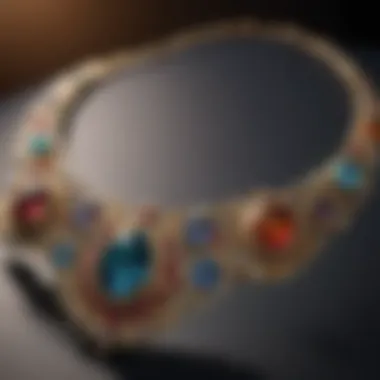
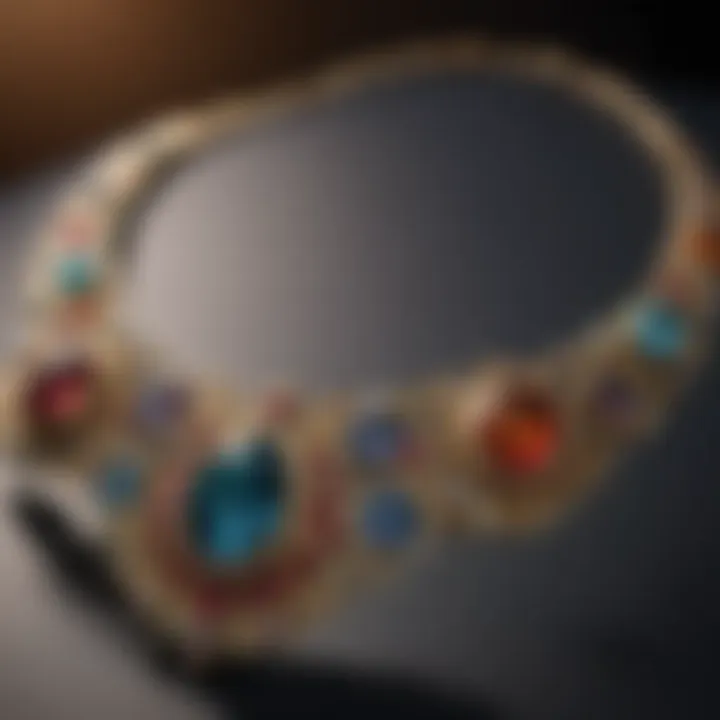
Intro
Gem necklaces have long captured the imaginations of people across different cultures and eras. They embody both beauty and deeper meanings, intertwining personal stories with ancestral traditions. When someone wears a gem necklace, it often reflects their intentions or feelings, possibly serving as a talisman or a conversation starter. This exploration digs into the world of gemstone jewelry, revealing how the artistry, history, and symbolism behind these pieces can influence individual choices and expressions.
Gemstone Overview
Definition and characteristics
At their core, gemstones are naturally occurring mineral formations that are admired for their luster, color, and rarity. Each gemstone tells a unique tale, shaped by geological processes over millions of years. The allure often goes beyond mere beauty; many gemstones carry connotations of strength, purification, and healing.
For instance, amethyst has a calming presence, believed to assist in mental clarity, while garnet radiates passion and energy. Notably, the physical properties, such as hardness and refractive index, can also influence a gemstone's perceived quality. Something to ponder is that not every sparkle signifies desirability; the story and sentiment imbued in each piece can often be more valuable than the stone's market price.
Classification of gemstones
Gemstones come in two primary categories: precious and semi-precious. Precious stones include diamonds, rubies, sapphires, and emeralds; these are often seen as more valuable due to their rarity and desirability. Semi-precious stones, including turquoise, opal, and topaz, while not as coveted in traditional markets, hold substantial cultural significance and aesthetic appeal.
"In the world of gemstones, value isn’t merely about price tags, but about the connections they forge and the stories they promote."
This distinction serves as a practical guideline, but individual appreciation varies widely among enthusiasts and collectors alike.
Properties of Gemstones
Physical properties
The physical properties of gemstones encompass attributes such as hardness, density, and brilliance. The Mohs scale, for example, rates the hardness of gemstones, ranging from 1 (talc) to 10 (diamond). Hardness can be crucial for wearability; softer stones may scratch easily, while harder stones offer durability. Brilliance, on the other hand, results from how well a gemstone reflects light. This can drastically affect how a gem is visualized in jewelry settings.
Chemical properties
Chemically, gemstones are made up of different elements that define their color and characteristics. For instance, the vivid blue of sapphire is due to the presence of iron and titanium. Understanding these chemical properties adds layers to the appreciation of gemstones beyond surface appearances. Such knowledge can guide collectors and designers alike in choosing the right gems for their desired effects and meanings.
The allure of gems encapsulates a blend of aesthetics, history, and personal significance. As we navigate through the intricate tapestry of gem necklaces, we uncover ample intersections of beauty and meaning in these captivating adornments.
Foreword to Gem Necklaces with Meaning
Gem necklaces hold a unique place in the world of jewelry, blending artistry with profound meaning. This section sets the stage for understanding how gemstones can convey emotional, spiritual, and cultural significance. Particularly, exploring gem necklaces allows one to appreciate the nuanced connections people form with these objects. Rather than being mere fashion statements, they often serve as personal talismans or family heirlooms, intertwined with memories and aspirations. The variety in styles, colors, and meanings amplifies their importance in personal expression.
In a world where self-expression and individuality are increasingly valued, the methods by which we adorn ourselves take on added depth. Gem necklaces, in particular, are more than decorative items; they symbolize choices and connections at various levels. Some individuals select stones based on their believed healing properties, while others dedicate them to specific life events, such as engagements or anniversaries. Understanding these layers contributes to a richer appreciation of the crafted beauty found in jewelry.
Defining Gem Necklaces
When we speak of gem necklaces, we’re referring to those pieces that incorporate natural stones, each with its distinctive color and texture. These necklaces often connect wearers to either natural beauty or spiritual elements. Take, for instance, the choice of gemstones in a necklace. Some people gravitate toward amethyst for its tranquility or pearls for their timeless elegance. The craftsmanship involved — choosing the right clasps, chains, and settings — turns these raw materials into something wondrous.
Gem necklaces range from simple pendants to elaborate multi-layered designs, showcasing not only the stone's colors but also the skill of the artisan. The intricacy of designs can vary significantly, reflecting both the wearer's taste and the cultural background behind the piece. Each necklace tells a story, whether it’s the gem’s origin or the significance it bears for the wearer.
The Cultural Significance of Jewelry
Jewelry, particularly gem necklaces, carry substantial cultural weight across different societies. In many cultures, specific stones are revered for their believed powers or ancestral ties. For instance, turquoise has been used for centuries in various Native American cultures as a protective talisman. Similarly, in several societies, carat weight often translates to luck and prosperity, further enriching the cultural narrative surrounding gemstone use.
"Jewelry is a way of keeping memories alive and retaining a connection to roots."
Throughout history, gem necklaces have served as symbols of status, love, and even faith. They can cross boundaries and tell global stories, linking us to the past while grounding us in the present. When you wear a particular stone, you're not just embracing its aesthetics, but also its history and significance, making it an integral part of your identity.
In summary, the topic of gem necklaces laden with meaning is a gateway into a fascinating world where history blends with personal expression. The choices we make around gemstones are often reflective of broader cultural values, personal beliefs, and shared experiences. Understanding this significance can deepen one's connection not only to the jewelry but also to oneself.
Historical Context of Gemstones in Jewelry
The allure of gemstones isn't just skin deep; their significance runs through the fabric of human history. Gemstones have held a unique place in jewelry throughout time, acting as symbols of status, power, and personal expression. Understanding the historical context of these stones sheds light on their lasting appeal and offers insight into how they influence modern-day designs and personal preferences. The rich tapestry of history reveals various societal values and beliefs that have shaped gem usage, making this examination not just intriguing but essential for anyone interested in the world of gem necklaces.
Ancient Civilizations and Gemstone Use
From the ancient Egyptians who adorned themselves with turquoise and lapis lazuli to the Romans who favored pearls and sapphires, gemstones have always been revered. In many civilizations, these stones were believed to hold magical properties or the essence of the gods. For instance, the Egyptians used stones like carnelian as offerings to ensure safe passage in the afterlife. Similarly, in China, jade was regarded as a symbol of purity and moral integrity, often used in ceremonial items. These ancient practices not only highlight the aesthetic value of gemstones but also point to their spiritual significance.
The mineralogical properties of certain stones often dictated their use; hardness, color, and clarity were attributes sought after. For example, the hardness of diamonds made them a natural choice for jewelry that required durability; their scarcity added to their allure. Additionally, the practices of extraction and trade in antiquity shaped the availability of different gemstones across cultures. Trade routes not only facilitated the exchange of goods but also led to the merging of customs and beliefs, as seen in how Indian rubies found their way into European royal crowns.
Evolution of Gem Necklace Designs
As civilization advanced, so too did the designs of jewelry. The evolution of gem necklace designs reflects shifts in aesthetics, technology, and cultural significance. In the Middle Ages, necklaces featured elaborate pendants, often with religious motifs and materials like gold and silver, aimed at showcasing faith rather than personal style. During this time, the wearing of gemstones was restricted to nobility, symbolizing wealth and divine favor.
The Renaissance saw a shift towards more intricate designs and the incorporation of nature-inspired motifs. Gemstones were cut into different shapes, which allowed for more light play and a sparkle that caught the eye. For instance, the transition from cabochon cuts to faceted stones radically transformed how light interacted with gems, enhancing their visual appeal.
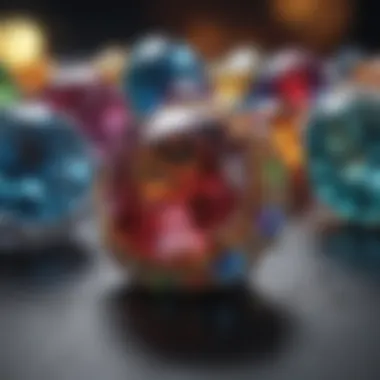

In the modern era, advancements in technology and a shift towards personal expression have resulted in a myriad of styles. Today, we see a blend of vintage and contemporary designs, merging traditional craftsmanship with modern sensibilities. The materials and methods continue to evolve; for instance, synthetic gemstones have entered the market, offering affordability without compromising on artistry.
Gemstones are not merely accessories; they are storytellers. Their history enriches our understanding of culture and personal identity.
As the significance of gem necklaces unfolds, it becomes clear that each stone carries layers of meanings influenced by historical context. The interplay of aesthetics, craftsmanship, and cultural norms creates a narrative that resonates with gem enthusiasts and collectors alike.
The Language of Gemstones
Gemstones have an age-old allure that extends far beyond their glittering surfaces. They tell stories that resonate through history and culture, acting as historical markers and symbols of identity. In this part of the article, we’ll unearth the layers of meaning that different gemstones possess, illustrating how they craft a unique language that communicates sentiments, beliefs, and personal narratives. The significance of these stones transcends mere ornamentation; they can be powerful conduits of emotion and intentions, influencing the wearer's choices and identity.
Symbolism Behind Different Gemstones
Each gemstone is steeped in its own tradition and lore, each with unique meanings that have evolved over time. For instance, consider sapphires, often associated with wisdom, dignity, and prosperity. In many cultures, wearing a sapphire is thought to bring clarity of thought, making it a favored stone among those in leadership roles. On the contrary, garnets symbolize passion and energy. Traditionally, they were believed to protect travelers, ensuring safe passage and protection from harm.
Here are a few other gemstones and their symbolic meanings:
- Emerald: Represents rebirth and love.
- Diamond: Denotes purity and strength.
- Obsidian: Seen as a protective stone that absorbs negative energy.
These meanings often inform how individuals select gemstones for necklaces—not just for aesthetics, but for the deeper significance that accompanies them. In essence, the language of gemstones becomes a personal lexicon, allowing individuals to communicate their values and intentions simply through their adornments.
Personal Interpretations and Connections
The connection one feels to a gemstone is deeply personal and varies widely. Take, for example, someone who grew up near the ocean; a necklace adorned with aquamarine may evoke memories of sunlit days by the shore. On the other hand, a collector who has spent years curating a collection may feel a strong attachment to a specific piece due to the joy of the hunt and the stories behind its acquisition.
These personal interpretations can be influenced by multiple factors:
- Cultural Background: Different cultures place varied significance on gemstones. For some, a specific stone may represent an entire familial legacy.
- Life Experiences: A person may wear a particular gemstone during a pivotal moment in their life, creating an emotional bond with it that speaks volumes.
- Spiritual Beliefs: Many enthusiasts align their gemstone choices with their spiritual practices, believing in the healing or protective properties certain stones possess.
"The stones we choose, more often than not, reflect who we are, what we believe, and where we've been."
In summary, the ability of gemstones to encapsulate emotions and reflect personal journeys makes them not only valuable as adornments but also as vehicles for expression and connection. As we move forward, understanding this language enhances our appreciation of gem necklaces and the intricate narratives they represent.
Exploring Healing Properties of Gemstones
The exploration of healing properties of gemstones serves as a fascinating intersection between culture, spirituality, and the natural world. For many, these stones encompass more than simply aesthetic appeal; they are believed to offer a plethora of benefits that can touch on physical, emotional, and spiritual realms. Understanding this dimension not only enriches our appreciation of gem necklaces but also enhances personal connections to these pieces, creating an underlying narrative of intention and purpose.
The Concept of Crystal Healing
Crystal healing, often shrouded in both mystique and skepticism, dates back centuries across various cultures. This practice posits that gemstones possess unique vibrational frequencies that can influence the energies around them. In essence, it’s suggested that the right gemstone can act like a balm to our ailments—both seen and unseen.
Consider for a moment how the sparkle of a clear quartz contrasts sharply against the deep greens of jade. Each energy emanates from these gems, believed to resonate with different chakras or energy centers in the body.
Moreover, crystal healing isn't just a laundry list of physical benefits. People often find solace in the emotional realms too. For instance, a person grappling with anxiety might turn to amethyst, renowned for its calming properties. Such gems can become talismans in a sense, offering support as one navigates the rocky terrains of life.
"Crystals are like nature’s offerings that, when understood, can guide and heal us in the toughest times."
Specific Gemstones and Their Attributes
The varieties of gemstones encountered in necklaces not only catch the eye but also cater to diverse needs and intentions. Here are a few notable examples:
- Amethyst: Often hailed as a stone of tranquility, amethyst is said to bolster emotional strength while helping to alleviate stress and fear. Its deep purple hues are visually calming and can be a wonderful addition for those seeking solace.
- Lapis Lazuli: Revered since ancient times, lapis lazuli is popularly associated with wisdom and self-awareness. Many use it as a channel to tap into one's inner truths. This vibrant blue stone supposedly enhances intellectual prowess, fitting well for scholars and thinkers alike.
- Citrine: Known as the merchant's stone, citrine is believed to attract wealth and prosperity. However, its warm golden tones also promote joy and positivity, making it an excellent choice for someone looking to uplift their mood.
- Rose Quartz: Often referred to as the love stone, rose quartz is connected with emotional healing. It advocates self-love and compassion, making it ideal for fostering healthy relationships.
Exploring these stones opens a doorway into personal meanings—they can become reflections of one's journey, guiding through the ups and downs of life.
Understanding the healing properties of gemstones can empower individuals to choose gem necklaces that resonate meaningfully with their lives. By embedding intention into these pieces, wearers create a deeper bond, allowing jewelry to serve not just as an aesthetic embellishment but a genuine companion in their life journey.
Craftsmanship in Gem Necklaces
Craftsmanship plays a pivotal role in the creation of gem necklaces, transforming raw materials into exquisite pieces of artistry that are both beautiful and meaningful. Jewelry-making is not merely a technical endeavor; it is an expression of creativity where each stage contributes to the final product's aesthetic and emotional resonance. Understanding the craftsmanship behind gem necklaces allows collectors, designers, and enthusiasts to appreciate the dedication and skill involved in this intricate art form.
Artisan Techniques in Jewelry Making
Artisan techniques are central to crafting gem necklaces. These techniques can vary widely across cultures and personal styles, but they share a common goal: to create jewelry that speaks to the wearer's spirit and individuality.
For instance, the technique of filigree involves twisting and soldering fine wire into delicate patterns. Originating centuries ago, it showcases the artisan's precision and patience. In contrast, stone-setting techniques determine the visual impact of the gemstone. Not only do these methods secure the stone, but they also enhance its natural beauty. The prong setting, where a gemstone is held in place with metal claws, allows maximum light to enter the stone, showcasing its brilliance.
Moreover, the craftsmanship can be quite labor-intensive. Many artisans employ traditional methods passed down through generations, such as silversmithing and lost-wax casting. Each technique has its quirks, requiring specific tools and a steady hand. It might take years of practice to master these crafts, but the outcome is worth the time.
Material Selection and Quality Assessment
Selecting materials is another critical aspect of craftsmanship. The right choice not only affects the durability of the necklace but also its overall visual appeal. Common materials for gem necklaces include various metals, gems, and even organic materials like pearls and corals.
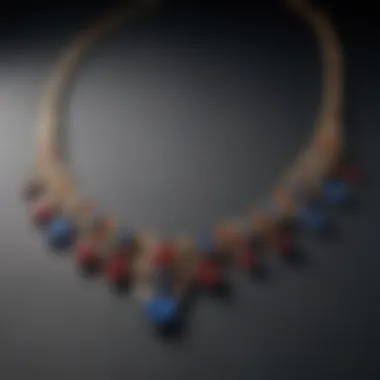
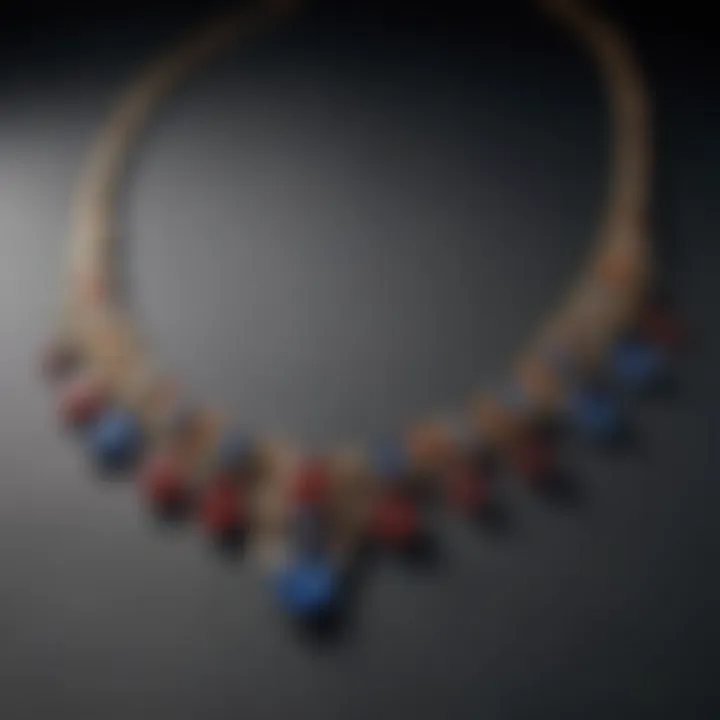
When it comes to gems, quality assessment is crucial. Characteristics such as color, clarity, cut, and carat weight determine a gemstone's value. A high-quality amethyst, for example, showcases a rich, vivid purple with few inclusions. Understanding these properties can help in making informed purchasing decisions.
As the jewelry industry is increasingly focusing on sustainability, the ethical sourcing of materials has gained prominence. Craftsmen are now considering the origins of their gems and metals, opting for those sourced responsibly, to minimize environmental impact, while still maintaining a commitment to quality.
"In jewelry making, it's not just about glimmer; it’s about the hidden stories within each piece, the hands that shaped it, and the eyes that appreciate it."
Choosing the Right Gem Necklace
Selecting a gemstone necklace is not merely about aesthetics; it's a deeply personal choice intertwined with one's individual essence. Each gem holds unique meanings and properties, allowing wearers to express their identity, emotions, and intentions. Understanding how to choose the right gem necklace is pivotal in ensuring that it harmonizes with your personal style and resonates with your life experiences.
Considerations for Personal Style
When it comes to personal style, the options for gem necklaces can be as varied as the stones themselves. One must first assess what aligns with their existing wardrobe and overall vibe. Do you lean toward boho chic, minimalist elegance, or perhaps vintage luxe? The necklace should be an extension of who you are.
- Shape and Cut: The cut of the gemstone can affect the overall impression of the piece. A faceted gem tends to reflect light beautifully, while a cabochon might offer a more subtle allure.
- Color Palette: Think about the colors you are most drawn to. A turquoise necklace might pop against earthy tones, while a deep red garnet could enhance a classic black outfit.
- Length and Style: The length of the necklace plays a significant role. A choker shapes a youthful appearance, while longer necklaces can lend a more sophisticated air.
Finding the perfect match means experimenting and identifying which style brings out the best in you.
Understanding Your Intentions
Intention is the driving force behind every jewelry choice. Why are you attracted to a particular gemstone? Is it the calming vibration of amethyst or the loving energy of rose quartz that draws you in? Each stone carries its own vibration, and aligning that with your intentions can lead to a meaningful connection.
- Celebratory Moments: If you are shopping for a milestone—like a birthday or graduation—consider gems that symbolize the qualities you want to harness in this new chapter.
- Daily Reminders: Some individuals choose gemstones to serve as daily reminders of their aspirations or affirmations. For instance, a necklace with a citrine stone can serve as a cheerful prompt to stay positive.
- Spiritual Significance: Many people buy gemstone necklaces for their metaphysical properties. Researching these attributes can help in choosing a gem that aligns with specific energies you want to attract or cultivate in your life.
Ultimately, marrying personal style with intention gives the wearer a sense of empowerment and connection that transcends the mere visual appeal of the necklace. Choosing the right gem necklace isn't just about beauty; it's about narrative and resonance, embodying stories you're ready to tell the world.
Popular Gemstones and Their Meanings
The exploration of gem necklaces takes on an added dimension when one considers the specific gemstones used within them. Not merely ornaments, these stones carry profound meanings and associations, often intertwining personal stories with history and culture. Choosing a gem is akin to selecting a part of oneself to display or a story to tell. This section specifically sheds light on the significance of popular gemstones, offering the reader insights into their meanings and the potential benefits they might bring.
Amethyst: Wisdom and Clarity
Amethyst often represents wisdom. This stunning purple stone is not just captivating to the eye, it has been revered for centuries. From ancient Greek times, people believed that wearing amethyst would prevent one from drunkenness and promote clarity of mind. This vibration of crystal energy resonates deeply, making it a favorite among those who seek mental peace and tranquility.
- Historical Ties: Amethyst has a rich history with ties to royalty and spiritual leaders. Many crowns and religious artifacts feature this beautiful stone, underlining its esteemed status.
- Spiritual Meaning: On a spiritual level, it is known to activate the crown chakra, enhancing meditative practices. Some say that wearing amethyst can assist one's intuition, guiding them towards better decision-making.
"Amethyst serves not only as a lovely accessory, but a beacon of wisdom and mental clarity in the chaos of life."
Rose Quartz: Love and Peace
Rose Quartz, often dubbed the "stone of love", brings warmth and gentleness. Its soft pink hue resonates with the energies of compassion and emotional healing. People often turn to this stone for comfort and to nurture their relationships, whether romantic or platonic.
- The Love Connection: This gem has been associated with love since ancient times. It is said that keeping rose quartz nearby invites love—both to yourself and from others.
- Emotional Healing: Furthermore, many believe that this stone can help mend emotional wounds. Its energy is seen as soothing and nurturing, guiding individuals toward self-acceptance and forgiveness.
Turquoise: Protection and Healing
Turquoise stands out with its striking blue-green color, symbolizing protection and healing. Many ancient cultures regarded it as a talisman against negative energies, believing that it could shield the wearer from harm. It has served as a treasured stone in various cultures—from Native American tribes to ancient Egyptians.
- Cultural Significance: Turquoise was often used in ceremonial jewelry and worn as a sign of wealth and social status. It is intertwined with spiritual beliefs; many carried it as a protective amulet.
- Healing Attributes: Today, the stone is acknowledged for its healing attributes. People claim that wearing turquoise can cleanse and heal emotions, providing a sense of inner peace and balance.
In summary, each of these gems—Amethyst, Rose Quartz, and Turquoise—holds a unique position when it comes to their meanings and the energy they carry. Understanding the significance behind these stones helps gem necklace enthusiasts make informed choices that resonate with their personal journeys and intentions.
Cultural Perspectives on Gem Necklaces
Cultural perspectives on gem necklaces provide a fascinating lens through which to explore their significance and role in various societies. Jewelry, particularly necklaces adorned with precious stones, transcends mere adornment; it embodies stories, traditions, and identities of people across the globe. Understanding these cultural ties brings depth to our appreciation of gem necklaces, highlighting how they intersect with personal and communal narratives.
Gemstones in Traditional Ceremonies
Across different cultures, gemstones often play pivotal roles in traditional ceremonies. For instance, in Indian weddings, a bride's jewelry is not just decorative; it serves as a symbol of prosperity and blessings. The use of gold and various gemstones is deeply rooted in cultural beliefs, where each stone carries specific meanings. Rituals involving the exchange of gemstone jewelry can signify not only marital commitments but also familial bonds and cultural heritage.
In certain African cultures, a necklace adorned with particular stones might be worn during rites of passage. These ceremonies are integral to one's identity and social standing. For example, the adoption of jade in Chinese traditions symbolizes virtue and moral integrity. Such precious gems can serve as talismans, believed to guard against misfortune or invite good luck.
Moreover, Native American communities recognize turquoise as a sacred stone. It is often used in ceremonies to promote healing and balance. These cultural practices highlight how gemstones act as conduits for spiritual connection and communal values.
"Jewelry is the most personal expression of who you are. In every gemstone lies the history of its people." - An anonymous jewelry enthusiast.
Regional Variations in Jewelry Significance
Jewelry significance, particularly in relation to gemstones, is not uniform worldwide; it varies from one region to another. In Western cultures, diamonds represent love and commitment, especially in engagements, while colored gemstones might be favored for their unique hues and individual meanings. Ruby is often linked with passion in North America, which generally favors vibrant colors that stand out.
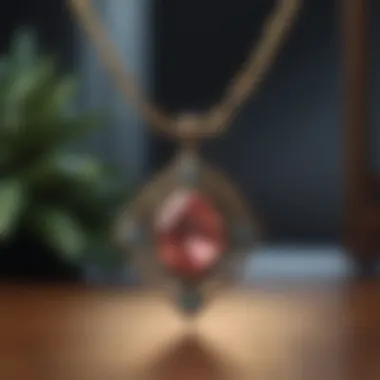
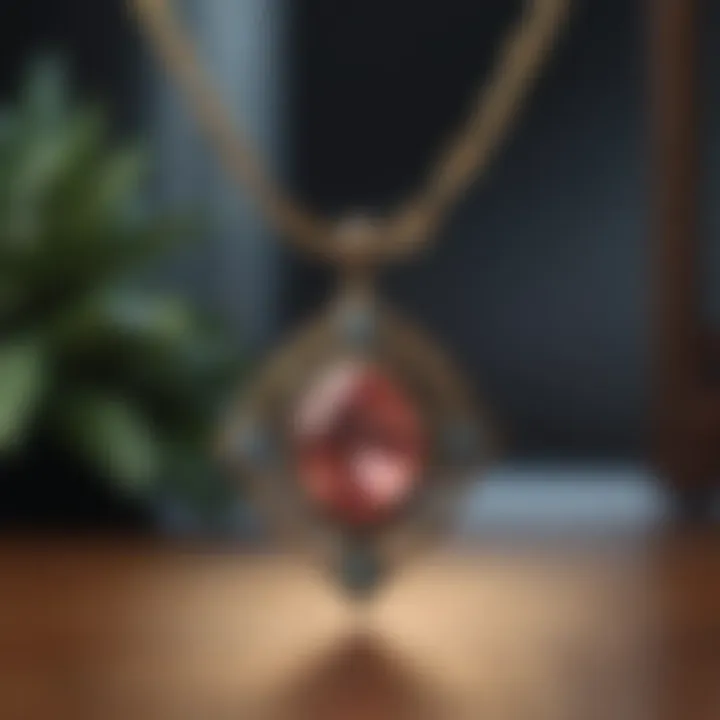
In contrast, in countries such as Egypt, where the famous blue lapis lazuli has been revered for millennia, its value lies in historical associations with royalty and the afterlife. Egyptians adorned themselves with lapis for protection and connection to the divine. Each region tells its own story based on local beliefs, available resources, and historical contexts.
Further, in South American cultures, emeralds hold a different significance as symbols of fertility and abundance. The connection to nature is more pronounced, reflecting a deep respect for the earth and its treasures.
The variations illustrate how gemstones are not merely fashion items but carry environmental, historical, and emotional weight, enriching our understanding when we wear or give them.
Finale
Cultural perspectives on gem necklaces illustrate that these pieces are far more than accessories. They encapsulate timeless traditions, celebrate significant life events, and convey emotional narratives across the globe. By delving into the cultural tie that gems have, we can glean rich tales about the human experience, making every stone and string of gems a story waiting to be shared.
Ethical Considerations in Gemstone Sourcing
In the intricate world of gem necklaces, the ethical sourcing of gemstones stands out as a vital element that intertwines moral responsibility with aesthetic appreciation. As consumers become increasingly conscious of the origins of their products, the implications of gemstone sourcing have garnered significant attention. This section delves into why understanding ethical sourcing practices is crucial, with a focus on specific elements and the broader benefits it entails.
Understanding Ethical Sourcing Practices
Engaging with ethical sourcing practices means supporting a system that prioritizes fairness, transparency, and sustainability. Here are several key aspects to consider:
- Fair Labor Standards: One of the primary concerns in gem sourcing is ensuring that workers are treated fairly. From miners to artisans, each person involved in the journey of a gemstone deserves equitable compensation and working conditions.
- Environmental Impact: The extraction of gemstones can profoundly affect local ecosystems. Ethical sourcing involves selecting stones from sustainable mines that employ practices aimed at minimizing environmental destruction and promoting biodiversity.
- Community Benefits: Ethical practices not only focus on the individual worker; they often extend to communities. Many companies now invest in local development programs that provide education and healthcare to populations affected by mining activities.
Companies that adhere to these principles often obtain certifications that validate their practices, providing consumers with a clear means of evaluating their purchases. This transparency creates a dialogue between jeweler and buyer and fosters an ongoing commitment to ethical practices.
The Impact of Conscious Consumerism
Conscious consumerism plays a significant role in reshaping industry standards in gemstone sourcing. When consumers make informed choices, they send strong signals to the market about the importance of ethical considerations. Here are a few ways conscious consumerism makes a difference:
- Increased Demand for Ethical Gems: As more individuals seek gem necklaces aligned with their values, jewellers are prompted to adapt their sourcing practices. This evolving demand encourages the industry to prioritize ethical methods over profit alone.
- Raising Awareness: When consumers choose sources that align with ethical guidelines, they elevate discussions regarding the human and environmental costs of gemstone extraction, prompting broader awareness in both communities and industries.
- Encouraging Accountability: Brands compelled to act ethically face heightened scrutiny. Buyers are armed with information, leading companies to implement more rigorous reporting practices and to embrace ethical standards wholeheartedly.
"The choices we make today shape the marketplace of tomorrow. By investing in ethically sourced gemstones, we contribute to a growing culture of responsibility and compassion across the globe."
Ultimately, by engaging with ethical considerations in gemstone sourcing, both consumers and producers can foster a more humane and environmentally conscious industry. Not only does this approach highlight the significance of personal style in the world of gem necklaces, but it also aligns adornment with values that respect both people and the planet.
The Future of Gem Necklaces
The landscape of gem necklaces is evolving, reflecting the fusion of personal expression and sustainability. This section examines the factors shaping the future of these exquisite adornments. The integration of modern design trends, the increasing significance of individual styles, and the emphasis on ethical sourcing are just a few key elements we will explore. Understanding these influences not only helps in appreciating the gems but also in making informed choices as consumers.
Trends in Gemstone Jewelry Design
As the world progresses, so does the design of gemstone jewelry, particularly necklaces. Unique trends arise each year, often influenced by cultural shifts, technology, and environmental consciousness. Currently, we observe a delightful mix of traditional craftsmanship with contemporary styling.
- Minimalism: There's a noticeable shift towards understated beauty. Designs that emphasize simplicity but with an elegant touch have become quite popular. These pieces often serve as the perfect backdrop for standout gemstones, highlighting their natural beauty.
- Personalization: Customization is on the rise. Many consumers now seek ways to tell their own stories through jewelry. Whether it’s engraved names, birthstones, or unique designs, personalization adds layers of meaning to each necklace.
- Nature-Inspired Designs: Bustling interest in nature has inspired a plethora of designs that echo organic forms. Gemstones set in settings that mimic natural elements tend to evoke a sense of earthy elegance.
- Mixed Materials: Jewelers are venturing beyond just gemstones and metals by incorporating materials such as wood, leather, and even upcycled elements. This eclectic mix speaks to a more sustainable approach to fashion.
These trends are reshaping how we view and wear gemstone necklaces. They transition from mere accessories to powerful expressions of individuality and consciousness.
Technological Innovations in Gemstone Processing
The future is not just about aesthetic trends but also about how these gemstones are processed and crafted. Technological advancements are revolutionizing the jewelry industry, enhancing both the quality of gemstone necklaces and the ethical standards behind their creation.
- Advanced Cutting Techniques: Modern cutting technology has made it possible to achieve intricate designs that were once impossible by hand. This innovation allows gem artisans to create stunning facets that increase light reflection and enhance the stone’s allure.
- 3D Printing: Emerging as a game-changer, 3D printing opens new avenues for designing unique settings that complement the gemstones perfectly. This method reduces waste and gives designers the freedom to experiment without the hefty costs traditionally associated with stone setting.
- Blockchain for Provenance: Traceability is a growing concern in gemstone sourcing. Utilizing blockchain technology ensures that consumers can track the journey of their gems from mine to market, offering transparency and building trust.
- Synthetic Gemstones: The rise of chemically constructed gemstones can’t be ignored. As more consumers become aware of the impact of mining, ethically-produced stones offer a sustainable alternative that doesn't compromise on beauty.
These innovations pave the way for a vibrant future in gemstone jewelry, presenting opportunities that align artistry with ethical responsibility.
"The future of gem necklaces is defined not only by their beauty but also by the environmental and ethical choices we make when acquiring them."
Embracing these advancements, jewelers can foster deeper connections between their creations and consumers, ensuring that every gem necklace tells a story—one of heritage, personal connection, and a thoughtful approach to sustainability.
Ending: The Lasting Appeal of Gem Necklaces
Gem necklaces are not merely adornments; they are vessels of meaning that capture personal journeys and cultural narratives. Their lasting appeal lies in a myriad of significant factors that resonate with individuals across different backgrounds and beliefs. This culminates in a jewelry piece that goes beyond the surface, serving as a reflection of personality, history, and even aspirations.
Reflections on Personal Connections
The beauty of gem necklaces is often intertwined with the connections they foster—not only to the wearer but also to the shared histories of family and friends. Wearing a necklace might evoke comforting memories of a grandmother's jewelry box or symbolize support during a challenging time. A piece adorned with a specific gemstone, like a sapphire symbolizing loyalty, can resonate deeply, particularly if gifted during a milestone event. These connections become stories, cementing the significance of the piece within one’s life, making it an intrinsic part of the wearer’s identity.
Moreover, the allure of personal storytelling is magnified by the unique attributes of each gemstone. For instance, if a father gave his daughter an emerald necklace on her graduation day, the jewel transforms from a simple accessory into a treasure chest of memories. Such connections drive individuals to cherish and wear their necklaces with pride, often passing them down as heirlooms.
Embracing the Stories Behind the Stones
It's essential to acknowledge the narratives entwined with gemstones themselves. Each gem carries its own set of myths and folklore. Stories range from ancient beliefs to modern interpretations. For example, amethyst, thought to ward off drunkenness in antiquity, symbolizes temperance and balance today.
Modern jewelers often strive to revive and celebrate these diverse histories, incorporating storytelling into their designs. Jewelry not only becomes a personal symbol but also a canvas reflecting age-old stories.
"A gem's beauty emerges not from its physical form but rather from the tales it carries within and the meanings it invites."
In this light, embracing the stories behind gemstones can elevate a simple necklace into something monumental. This perspective encourages mindfulness in purchasing. Rather than just selecting for aesthetic purposes, collectors and enthusiasts can ponder the deeper meanings behind specific stones and their historical contexts.
Lasting appeal emerges from this dual connection: the personal bond with the necklace and the broader narrative that contextualizes the gemstone within human history. The nuanced relationship between wearer and jewelry enables gem necklaces to serve as tangible pieces of art that transcend mere fashion, becoming embodiments of values and stories.



